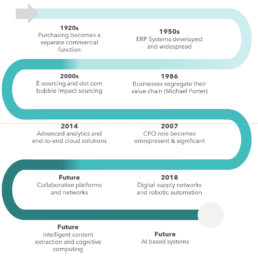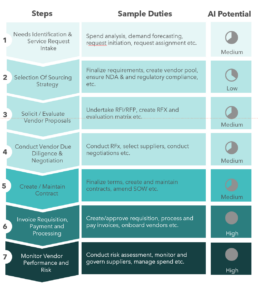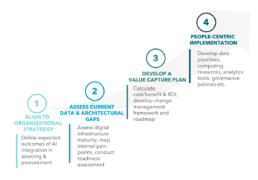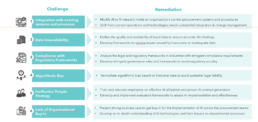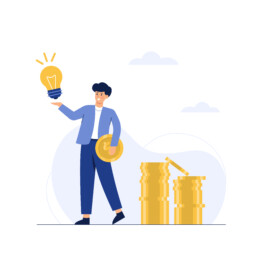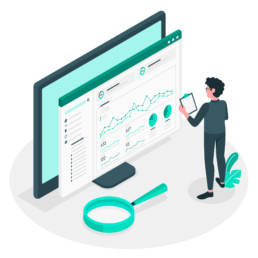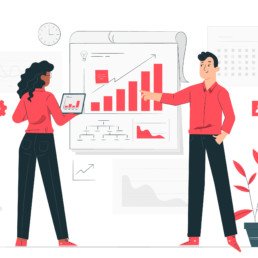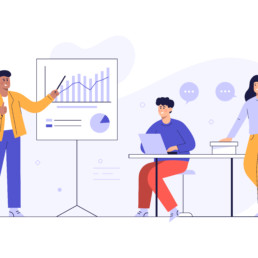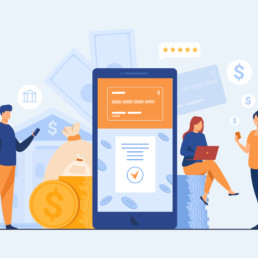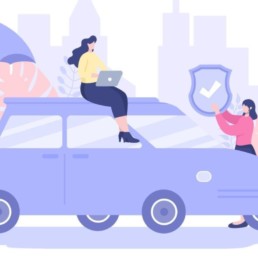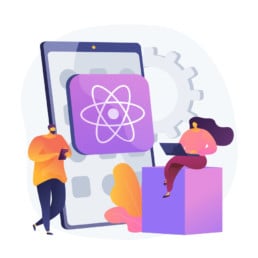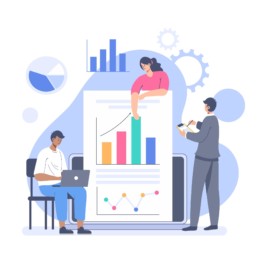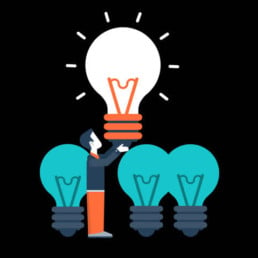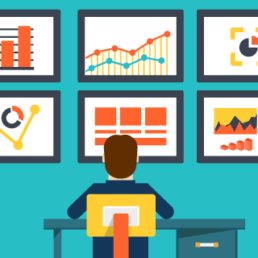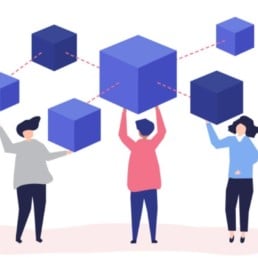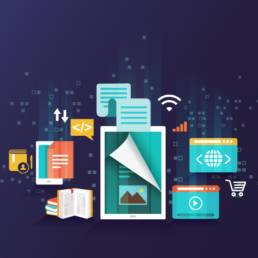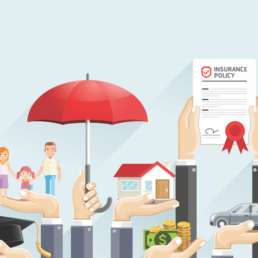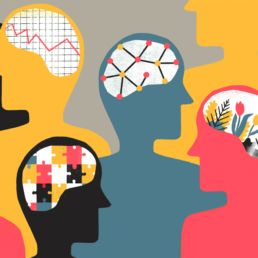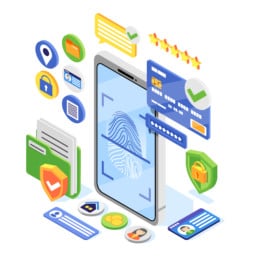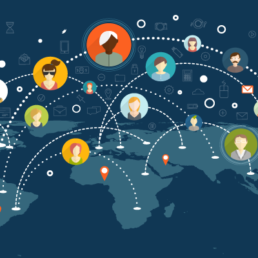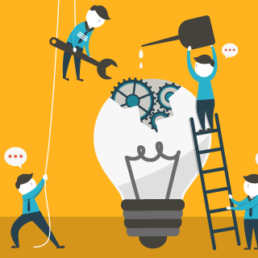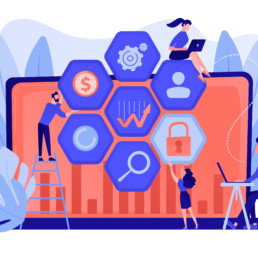The Evolution of Procurement
Procurement is one of an organization’s crucial and oldest roles, closely intertwined with strategy, risk, digital innovation, and financial stewardship. Over the last 20 years, technological advancements such as cloud-based platforms, data analytics, and intelligent automation have greatly contributed to the increased effectiveness of procurement teams. These advancements have propelled procurement from a transactional role, and into a more strategic one focused on meeting the long-term goals of the organization.
Procurement teams are seeing a significant increase in risks and supplier management issues. This has driven the need for tools to continuously monitor third-party relationships, ingest large amounts of data, and utilize advanced KPI analytics and preventive management. Meanwhile, the top priorities for CPOs remain driving operational efficiency, digital transformation, and improving margins(1). Almost 45% of executives said they are accelerating digital transformation to achieve their goals, 51% are using advanced analytics and 25% have, or are piloting, an AI/cognitive solution(2). Spending on technology has increased by 6% in the past year and does not show signs of slowing down(3). The adoption of advanced analytics presents a unique opportunity to increase competitiveness and control third-party spending in a way that supports broader organizational goals.
Exhibit 1. Developments in Third Party Procurement
How is AI Relevant
Under the umbrella of AI, there are a multitude of self-learning or smart algorithms that replace manual processes. Through AI, ML, NLP, intelligent RPA, fuzzy logic, pattern recognition, automated data extraction, etc. procurement can gain insight into large amounts of data analytics at a faster pace.
In the realm of procurement, AI not only simplifies routine tasks but also tackles intricate challenges through computational problem-solving. Functions such as contract management, procurement assistance, strategic sourcing, and spend analysis can be automated. Moreover, AI empowers procurement experts with rapid data-driven insights that surpass human capacity, facilitating faster insights and informed decision-making.
Across the Procure to Pay (P2P) process, AI can deliver value at almost every step of the way. Arduous and manual processes can become a thing of the past, with AI paving the way to pursue digital transformation and modernize the procurement landscape.
Exhibit 2. Potential for AI in the P2P Process
AI Use Cases in Procurement
Spend Analysis:
Spend analysis is one of the key duties of the CPO office. It helps uncover new business needs, and purchasing trends, maintain expenditure reports, etc. Through AI, the procurement office can automate spend (cube) analytics. AI can dynamically search through AP & GL line-item details and scan keywords to categorize spending intelligently. By linking together account descriptions, supplier names, etc., using NLP, spending can be categorized with almost 97% accuracy(4). This dramatically reduces the need for ineffective manual searches. AI also automatically consolidates data on clients, spending, transactions, pricing, suppliers, contracts, RFPs, POs, spend reviews, contract management, e-catalogs, SRM systems, expense reports, etc.
Demand Forecasting:
Since AI can parse through vast amounts of data, it can identify shifts in global supply trends across a wide range of commodities and products. This allows it to uncover future trends and help inform the sourcing strategies. For example, ERPs like Tranquil with inbuilt AI capabilities can study your patterns and analyze past behavior to offer smart vendor recommendations for the future. Furthermore, AI can signal relevant external factors such as geopolitical risks, natural disasters, and market disruptions that may impact supplier performance and availability.
RFX Design and Evaluation:
Generative AI offers small procurement teams enhanced efficiency, customization, and adaptability in the RFP process. To integrate AI effectively, it must be trained with industry-specific terminology, RFP best practices, and organization-specific guidelines (e.g., selecting the right template). Once trained, the AI algorithms can seamlessly integrate into the procurement workflow for continuous use. Moreover, AI can simulate complex negotiation scenarios, aid negotiators in identifying effective supplier tactics, and reduce transactional and manual tasks.
Supplier Selection and Management:
AI plays a pivotal role in optimizing supplier management and the discovery of new suppliers. It achieves this by evaluating supplier capabilities, performance, and associated risks by analyzing historical performance data and product specifications. AI systems can track vast amounts of KPIs and real-time project performance. Furthermore, the implementation of a Generative AI chatbot can centralize communication related to supplier onboarding and access provisioning, as well as address inquiries 24 x 7. This strategic approach mitigates onboarding challenges and enhances supplier comprehension of the company’s specific business requirements, ultimately expediting the delivery of value.
Contract Management:
Disorganized contracting results in a loss of up to 40% in value for businesses and prolongs invoice processing times to ~25 days(5). Effective AI solutions streamline contract management by standardizing templates, automating initial agreement drafts, and managing the negotiation workflow. This entails consolidating contracts in one location with a complete audit trail, including escalations and approvals. AI-powered Contract Lifecycle Management (CLM) tools facilitate contract generation, negotiation, and risk identification. Computer vision and NLP can swiftly extract data from invoices, reducing fraud and manual processing times to 30-60 seconds. They can also retroactively process historic invoices for deeper insights when detailed data is lacking.
Vendor Risk Management:
AI transforms vendor management by rapidly identifying risks, automating document creation, analyzing policy compliance, and organizing data for detecting non-compliance. It also streamlines expense and invoice auditing thereby reducing manual hours for the procurement team with the ability to quickly sort through vast amounts of data. Additionally, AI-enabled Legal Language Models (LLMs) evaluate contract language across suppliers, uncovering key risks and optimization opportunities. This comprehensive AI-driven approach enhances modern supplier and vendor management, ensuring efficiency and compliance.
Getting AI Integration Right
Kepler Cannon recommends a ‘user-first’ approach to AI-enabling Procurement.
A user-first approach increases the effectiveness of supplier relations and enhances user experience/engagement of colleagues across the organization The implementation across the P2P-related ecosystem will support an updated operating model, moving away from manual and transactional tasks and focusing on strategic goals.
Exhibit 3. Key to Successful AImplementation
Alignment to the Organizational Strategy:
To gain stakeholder buy-in, CPOs must ensure alignment of the team’s goals with the overall organizational strategy. The first step is to ensure a business-driven mindset toward adopting AI. This can be done by identifying, building, and scaling key use cases for AI integration by listening to and addressing key pain points throughout the P2P process. ~40 percent of the end-to-end P2P process is automatable with technologies that are already deployable today(7). The deployment of such technologies should take into consideration the impact it would have on the user (e.g., CFO, CHRO, CFPA, COO, etc.) and supplier experience. Outlining a clear strategy and expected outcomes is the first step towards creating value instead of becoming a bottleneck.
Current Data & Architectural Gaps:
Procurement should work in partnership with leadership to examine the data landscape and privacy measures, ascertain how they correspond with company priorities, and ensure that procurement teams have access to the appropriate data. The business must then conduct an architectural review considering infrastructure, data architecture, and analytics. Here, the emphasis is on identifying the improvements that may be made using the current architecture and the areas in which extra funding may be required for the transformation. This enables a business to decide which user experiences should be prioritized for digitization today and which mid- to long-term architecture investments are necessary to realize the full potential indicated.
Flexible Value Capture Plan:
The typical digital procurement transformation lasts 18–24 months. Individual initiatives and the overall roadmap should be regularly reviewed and flexibly adapted as further nuances are uncovered during this journey8. The implementation of AI infrastructure should be carefully considered to calculate the cost/benefit and expected ROI. Generally, firms save 5-40% via the use of AI(9). However, a specific analysis of your unique environment is needed to build an accurate business case. Keep in mind that sometimes 100% automation isn’t realistic and that some tasks may continue to require a human touch. The 80/20 rule can be used to estimate the value available for capture.
People-centric Implementation:
Key activities to kickstart the AI procurement journey are proper architecture and governance, close cost monitoring, and comprehensive people strategy. Prioritize a people-centric approach by developing talent pipelines comprising procurement specialists and data scientists. These individuals should possess the expertise to adapt foundational models and seamlessly integrate them into applications. Companies can promote ecosystem innovation by collaborating with strategically managed service providers, granting access to specialized talent, industry knowledge, and cutting-edge automation platforms.
Benefits of AI in Procurement
In a competitive business environment, high-performing CPOs are 18x more likely to fully deploy AI/cognitive capabilities. This typically leads to 92% faster demand forecasting, on average 350 man-hours are saved through automation, and there is a potential for 24/7 operations(10).
AI in procurement also leads to agile decision-making, reliable analyses reduced risk across the organization, and 5-40% new savings through supplier rationalization and spend analytics(11).
Using AI for contract analysis, a global enterprise discovered 70+ duplicate licenses for the same vendor, scattered across regions and units leading to 33% savings(12). In another case, the U.S. Department of Health and Human Services (HHS) used AI in a procurement improvement initiative. AI analyzed 2 million contracts and 5-7 billion words, aiding comparison and cost reduction(13).
Recently, HSBC procurement announced that it aims to cut costs, accelerate decision-making, and get access to the best suppliers by adopting Globality’s artificial intelligence (AI)-driven self-serve procurement platform.
No Pain No Gain
Naturally, the adoption of new technology, systems, and procedures affects the larger organization in practical ways. It can be difficult to successfully integrate a system within the current business ecosystem. This is exacerbated by the fact that vendors, knowledgeable resources, and occasionally the technology itself are still developing. Being prepared for what to expect is the first obvious step in planning mitigating actions when preparing for implementation.
Exhibit 4. Mitigating Challenges of AI-mplementations
In Closing...
To future-proof Procurement, most CPOs are designing operating models that enable strategic thinking, supplier collaboration, and risk management. The integration of AI is a key addition to these priorities. It enables advanced spend analysis, demand forecasting, stronger supplier relationships, sharper risk management, reduced manual effort for RFx or supplier support, etc.
Forward-looking CPOs can reap the benefits of AI by using a user-first approach to their AI transformation. This includes aligning with the organizational strategy, assessing current data and architecture gaps, ensuring a value capture plan, and embarking on a people-centric implementation.
Separating strategic work and tactical work enables a more agile, aligned, and effective procurement model critical to the success of any organization.
__________________________________________________________________________________________________________
- The Hackett Group: Procurement Key Issues: What’s Top of Mind for Executives in 2023
- Everest Group (2023): Unleashing the Power of Generative AI in Procurement
- The Hackett Group: Procurement Key Issues: What’s Top of Mind for Executives in 2022
- AI Multiple (2023): AI in Procurement
- HBR (2023): Managing Procurement Risk
- 1
- McKinsey (2018): Digital Procurement
- McKinsey (2018): Digital Procurement
- HBR (2022): Procurement Teams Are Moving From Cost-Cutters to Growth Enablers
- SAP (2022) SAP AI and RISE with SAP AI Infographic
- GEP (2023) Adopting AI Responsibly
- Microsoft (2022): AI: What you Need to Know Now
- Global Trade Mag (2022): How to Successfully Incorporate AI in Procurement
